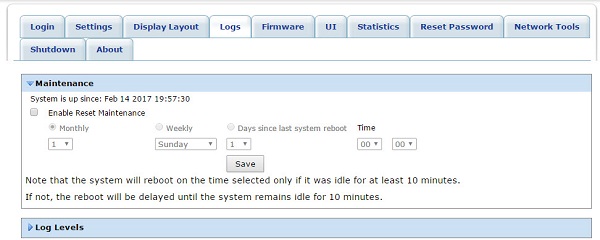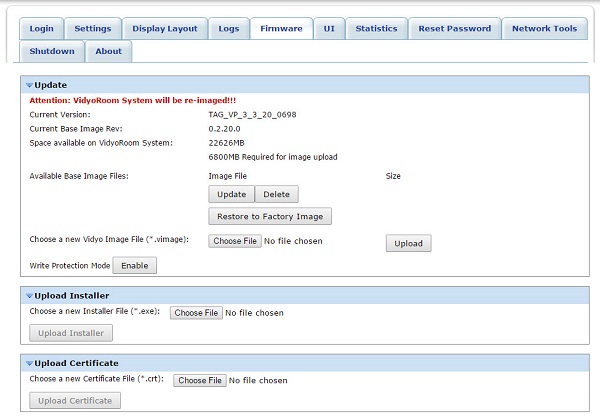Weekly reboot of VidyoRoom systems
This section contains information on how to perform a weekly reboot of your VidyoRoom systems.
|
Note Whenever you enable Write Protection Mode for a VidyoRoom system, you must also configure that system to automatically reboot on a weekly schedule. |
In VidyoRoom version 3.3.19, Vidyo introduced Write Protection Mode. This feature added full File Based Write Filtering and was recommended for deployments where the probability of ungraceful shutdowns was high and where the VidyoRoom systems were previously unable to recover.
According to Microsoft’s Overview of Windows Embedded Versions document, which you can find at https://www.microsoft.com/en-us/download/details.aspx?id=51484, write filters are designed to limit or, in some cases, prevent any writes from occurring to a disk or selected partition(s).
- The advantage of write filters is that they can significantly help to minimize disk corruption. They can help prevent a system from being permanently infected or altered (such as by a virus or malware).
- Write filters do have some disadvantages, however. User data can be lost, and the write filter overlay can fill up over time. This can limit the potential maximum system uptime before a system reboot is needed. If the overlay space becomes exhausted, the system can become unresponsive and eventually crash.
When Write Protection Mode is enabled on VidyoRoom systems, it protects selected partitions from writes at the sector level. This means that everything on the protected partition can be read from; however, any attempt to write to the disk caches in an overlay. As the overlay becomes full, the system must be rebooted in order to free up the overlay space. If the reboot does not occur, the system could become unresponsive or crash.
Configure a weekly reboot maintenance schedule
Before you enable Write Protection Mode on a VidyoRoom system, you must configure that VidyoRoom system to automatically reboot on a weekly schedule as described in this section.
Please note that some VidyoRoom versions already have automatic reboots scheduled to occur on a weekly basis whether or not you perform the configuration. Nevertheless, Vidyo recommends that you follow the steps in this section in order to pick the particular time at which you want your reboots to occur.
|
Caution If you fail to configure the weekly reboot maintenance schedule and your system does not have automatic reboots scheduled, the write filter will fill up over time, which could cause the system to become unresponsive and eventually crash. |
To configure a weekly reboot maintenance schedule:
- Log in to the VidyoRoom Admin UI.

- Click the Logs tab.

- If needed, click the blue triangle next to the word Maintenance to view the maintenance settings.
- Select the Enable Reset Maintenance checkbox.
- Select the Weekly radio button and select a day to set your system to reboot on that day each week.
- Select the hour and minute at which you want the system to reboot from the Time drop-down.
If you have multiple VidyoRoom systems, Vidyo highly recommends configuring the systems to reboot at different times (preferably at least one minute apart). For example, you could set one VidyoRoom system to reboot at 1:00 AM, another to reboot at 1:05 AM, another to reboot at 1:10 AM, and so forth. Doing so prevents unnecessary load on the portal that could occur if all the VidyoRoom systems tried to log in to the portal at the same time.
- Click Save. The VidyoRoom system will automatically reboot each week at the day and time you selected.
To prevent the system from rebooting while your users are using it, the reboot only occurs if the system has been idle for at least 10 minutes. If 24 hours pass from the time the reboot was scheduled to occur and the system is not idle for at least 10 minutes during that 24-hour period, the reboot is skipped. Therefore, to ensure that the reboot occurs, select a day and time when users would be least likely to use the system.
For example, if a reboot is scheduled for every Tuesday at 3 AM, but the VidyoRoom is in a call on Tuesday at 3 AM, the reboot does not occur. The system would then wait for the VidyoRoom to be idle for 10 minutes so that it could reboot. If the VidyoRoom continues to have users joining and leaving calls every 5 or so minutes until Wednesday at 3 AM, the reboot window would pass, and the VidyoRoom would not attempt to reboot until the following Tuesday at 3 AM (that is, six days later).
Enable write protection mode
After you have configured the VidyoRoom system to automatically reboot on weekly schedule, you should enable Write Protection Mode.
If you enable Write Protection Mode before configuring the automatic reboot schedule, the schedule will be lost when the VidyoRoom system reboots.
When you enable Write Protection Mode on a VidyoRoom system, the following occurs:
- All configuration changes and new logs are kept in a cache. If your VidyoRoom system loses power, all logs that have not been saved will be lost. Additionally, configuration files will not be saved and the system will restart with the configuration that was saved before Write Protection Mode was enabled.
- If the VidyoRoom system attempts to download a new Installer from the VidyoPortal but there is not enough room in the write cache, the VidyoRoom will not download the Installer. Instead, it will continue to check every three hours, and it will download the Installer when there is enough room.
- The log files are named as follows: VidyoRoom.0 – VidyoRoom.9. The limitation on the file size is 110 MB. Therefore, when the log file size reaches this level or upon restarting the VidyoRoom system, a new log file is created.
You can use the VidyoRoom Admin UI as described in the following steps to enable Write Protection Mode. For more information, refer to the VidyoConnect Room and VidyoRoom Administrator Guide.
To enable Write Protection Mode:
- Log in to the VidyoRoom Admin UI.

- Click the Firmware tab.

- If needed, click the blue triangle next to the word Update to view the update settings.
- Select Enable to enable Write Protection Mode. The Reboot Required pop-up appears.

- Click Yes. The system reboots. In order for the reboot process to fully complete, you are not allowed to click the Enable button more than once.